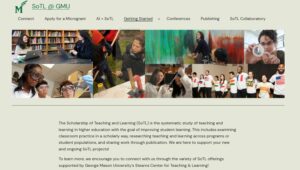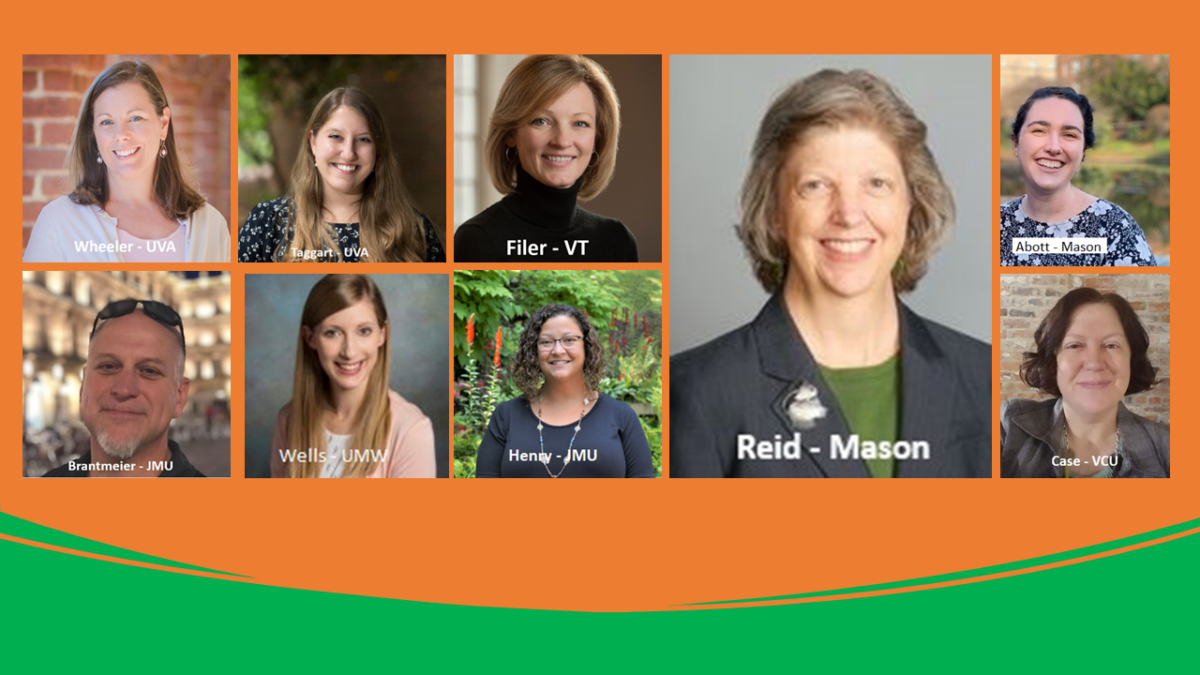Effective teaching is a cornerstone of Virginia higher education. To attain that critical bar, it is essential that successful teaching strategies are created and maintained, and that they meet students’ needs. This necessitates classroom-based research — known as the Scholarship of Teaching and Learning (SoTL). Faculty-focused SoTL research achieves multiple objectives including identifying best practices in educational strategies for a specific field and promoting a university’s overall teaching excellence.
While SoTL is crucial to gain a greater understanding of what works and what doesn’t work in the classroom, very few faculty are prepared to conduct such research independently. Thus, support for SoTL frequently falls to campus Centers for Teaching and Learning (CTLs). CTLs are generally small and tasked with a wide range of faculty assistance, so identifying appropriate SoTL strategies presents a time and resource challenge.
This dilemma faced the Stearns Center at Mason as well as three other 4-VA schools — Virginia Commonwealth University, Virginia Tech, and the University of Virginia. Each wanted to address the SoTL gap. The solution was recognized via a 4-VA Collaborative Research Grant, allowing the schools to work together to create sustainable SoTL programming. The goal was to create or refine plans for engaging and supporting faculty in SoTL at their specific institutions, to develop and investigate the impact of cross-institutional support programming for faculty developers, and ultimately improve the research competitiveness of faculty at each institution. Although not part of the 4-VA partnership, the prospect of such work also attracted the attention of faculty at Mary Washington University who were interested in joining the effort.
Led by the Stearns Center for Teaching and Learning Director, Shelley Reid, with key support from Mason graduate assistant Sophia Abbot, the team represented a state-wide effort, including Ed Brantmeier, Interim Executive Director/Assistant Director of the Center for Faculty Innovation (JMU); Dayna Henry Assistant Director of the Scholarship Area at the Center for Faculty Innovation (JMU); Kim Case, Director of Faculty Success (VCU); Kim Filer, Associate Vice Provost for Faculty Development/Director of the Center for Excellence in Teaching and Learning (VT); Lindsay Wheeler, Assistant Director of STEM Education Initiatives at the Center for Teaching Excellence and Jessica Taggart, Postdoctoral Research Associate (UVA); and Melissa Wells, Assistant Professor/Faculty Fellow of the Center for Teaching (Mary Washington). “Through our 4-VA@Mason grant, as well as the Complementary Grants at our 4-VA partner schools, we saw an opportunity to help CTLs avoid ‘reinventing the wheel’ in a key area of faculty support,” explained Reid. “SoTL is a growth area for CTLs, and this grant provided an opportunity to design that growth intentionally and collaboratively—and then to share the model with other CTLs nationally.”
Together, the group researched and built effective support structures for SoTL training. As a “community of practice,” the group met regularly to exchange strategies already in use and constructed additional strategies and resources for both CTL leaders and faculty. Next, they developed and presented workshops for national and local audiences to guide other CTL leaders in building collaborative structures. At these workshops, attendees learned about evidence-based models, common SoTL support programming across institution types, and received peer feedback on their plans. Presentations were made at the Professional & Organizational Development in Higher Education Network Conference, the International Consortium for Educational Development, the Innovations in Teaching and Learning Conference (Mason), the International Society for the Scholarship of Teaching and Learning Conference on Higher Education Pedagogy (VT), and an online workshop for SCHEV (VCU).
 Next, the team created online resources, an open access trove of tools for SoTL developers, including a Taxonomy of common language and organizational structure for understanding a variety of SoTL program models — organized by program type with a detailed description of each model. It also includes examples to further support readers’ envisioning of program possibilities. Further, visitors can access a strategic plan worksheet, which guides SoTL developers through the details of their aspirational and future plans in the context of their institution and provides a venue to receive peer feedback on specific aspects of their plan.
Next, the team created online resources, an open access trove of tools for SoTL developers, including a Taxonomy of common language and organizational structure for understanding a variety of SoTL program models — organized by program type with a detailed description of each model. It also includes examples to further support readers’ envisioning of program possibilities. Further, visitors can access a strategic plan worksheet, which guides SoTL developers through the details of their aspirational and future plans in the context of their institution and provides a venue to receive peer feedback on specific aspects of their plan.
The group continues to spread the word about effective SoTL practices through the following publications:
- International Journal of Academic Development Impact of a Regional Community of Practice for Academic Developers Engaged in Institution-Level Support for SoTL (Lukes, Abbot, Henry, Wells, Baum, Case, Brantmeier, & Wheeler)
- To Improve the Academy Strategic Planning Tools for Educational Developers Supporting SoTL Cultures and Programs at their Institutions (Lukes, Abbot, Wheeler, Henry, Case, Wells, Brantmeier)
- New Directions for Teaching and Learning Examining a Regional Educational Developer Community of Practice for Advancing Institutional Cultures of SoTL Engagement (Abbot, Lukes, Baum, Case, Henry, Brantmeier, Wheeler)
“Our team members have been particularly excited about the positive reception of the collaborative model through the well-attended national workshops. We’re looking forward to the conversations that are made possible through the multiple publications that will increase our audience and enable other CTLs to build their own collaborations.” concludes Reid.

